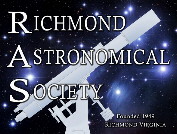RAS tries to motivate students to learn about astronomy in several different ways. In addition to holding many skywatches with schools and scouting groups, we also hand out money at one of the bigger science fairs: The Metro Richmond Science Fair. This fair draws students from the greater Richmond area, and usually ends up with two or three hundred projects.
RAS sends a scouting committee of two or three members, and we look for projects that show some use of astronomy in the subject matter. This year, Jim Browder and I were the committee. Then, we hand out checks, totaling in the neighborhood of $200. And better yet, we get to give out the checks at an awards assembly. No matter which high school the fair is held at (this year it was at Powhatan High), the auditorium is always full of kids enthused about science.




As the representative of RAS, I’ve given out the awards for about ten years now, and I have to say, this is one of the highlights of my year. It’s always thrilling to hear the students cheer a winner from their school, and to see the excitement on the kids’ faces when they hear their name announced. If you’ve ever been to a US FIRST Robotics competition, you know what I mean.
I also give out “Milky Way” awards–which is always a hit. After I give out the monetary awards, I award Milky Way candy bars to students who can answer each of two questions. One is always a “gimme” –the students know it’s coming, so it’s a good way get things rolling. The fair is always held in late March or early April, so I ask what astronomical event occurred X days ago. Then, I try to get a little more challenging. I try not to make it too easy, yet cover something that they had to have been paying attention to, about something happening in astronomy.
I thought maybe this year I’d really push it, and ask about something that happened historically–what was the name of the satellite that Russia launched 50 years ago? I was not disappointed–5 or 6 kids yelled out the answer withing seconds. I was so gratified, because I had a backup question ready, and I really didn’t want to resort to it. Hooray for our education system.
Here are the winners. Sometimes we’re disappointed and there are not many astronomy projects to pick from. This was a good year.
Justin Lau, The Effect of Solar Wind Speed on the Strength of Geomagnetic Substorms, Moody Middle.
Isaac Steincamp, Celestial Motion: The Difference Between Stellar and Planetary Motion, Manchester Middle.
Anisha Rohatgi, The Effect of Distance of the Light Source on the Intensity of Skyglow, Moody Middle.
Zachary and Benjamin Terner, The Effects of Coronal Mass Ejection on Muon Event Frequency at a Local High School, Godwin High.
[HTML1]
